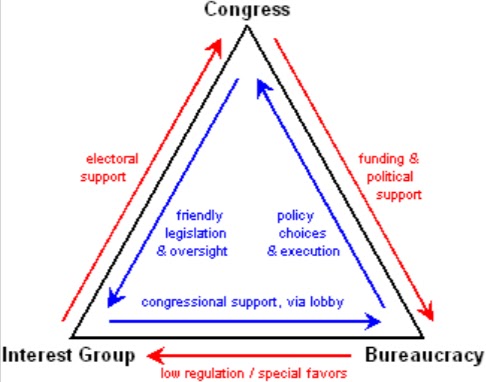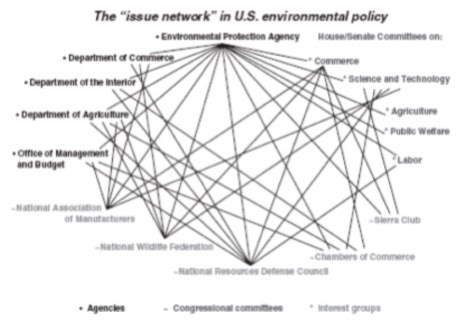S
Samantha Howey
Riya Patel
AP US Government 👩🏾⚖️
240 resourcesSee Units
Introduction
The bureaucracy is a large and complex system of administration consisting of appointed officials. It features a hierarchical authority structure, job specialization, and established rules and procedures.
The bureaucracy is responsible for implementing, administering, and enforcing policies, laws, and regulations at the federal level. This is done through a variety of different agencies, such as departments, commissions, and government corporations, each with their own specific areas of responsibility.
In addition to implementing and enforcing policies, the bureaucracy also plays an important role in regulating various industries and activities, such as the environment, finance, and telecommunications. This may include issuing fines and penalties for noncompliance, as well as conducting investigations and enforcement actions to ensure that policies are being followed.
The bureaucracy also interacts with other branches of government, such as the legislative and judicial branches. For example, representatives from federal agencies may testify before Congress on various policy issues, and the bureaucracy may be called upon to provide expert testimony in legal cases.
Overall, the bureaucracy plays a critical role in the functioning of the U.S. government, by carrying out the day-to-day tasks of implementing and enforcing policies and laws, and ensuring that regulations and programs are implemented effectively and efficiently.
Key Questions
- What is bureaucracy and why is it important in government?
- What is the role of bureaucracy in implementing and enforcing policies and laws in the United States?
- How does the bureaucracy interact with other branches of government, such as the executive, legislative, and judicial branches?
- What is the process for creating and modifying bureaucratic agencies and regulations?
- How does bureaucracy impact public policy and decision-making at the federal level?
- What is the role of bureaucracy in protecting the public interest and serving the needs of citizens?
- How is bureaucracy accountable to the public and the political branches of government?
- How does the bureaucracy affect the implementation of federal programs and initiatives, such as healthcare, education, and national security?
- What is the relationship between bureaucracy and interest groups, such as advocacy organizations and corporations?
- How does the bureaucracy interact with state and local governments in implementing federal policies and programs?
Key Vocabulary
- Bureaucracy: A large administrative organization that carries out the day-to-day tasks of implementing and enforcing policies and laws.
- Executive branch: The branch of government responsible for carrying out laws and policies, and includes the President, Vice President, and the various executive departments and agencies.
- Regulatory agencies: Independent agencies, such as the Environmental Protection Agency (EPA) and the Federal Communications Commission (FCC), responsible for creating and enforcing regulations in specific areas of policy.
- Civil service: The permanent, professional, and merit-based workforce of the federal government, responsible for carrying out the day-to-day tasks of the bureaucracy.
- Red tape: A colloquial term used to describe the bureaucratic procedures, regulations, and paperwork that can slow down or impede the efficient functioning of government.
- Administrative law: The body of law that governs the creation and implementation of regulations by bureaucratic agencies.
- Rulemaking: The process by which bureaucratic agencies create and implement regulations, including a period for public comment and potential legal challenges.
- Interest groups: Organizations, such as advocacy groups and corporations, that seek to influence public policy and decision-making.
- Iron triangle: A term used to describe the relationship between interest groups, bureaucratic agencies, and congressional committees, in which each entity has a vested interest in preserving the status quo.
- Mission creep: The tendency for bureaucratic agencies to expand their responsibilities and authority over time beyond their original intended purpose.
Types of Bureaucratic Agencies
There are several types of bureaucratic agencies in government, including:
- Executive agencies: these agencies are responsible for enforcing laws and regulations and are headed by an appointed official who reports directly to the President.
- Independent agencies: these agencies operate outside of the control of any one particular department and have a specific mission or function, such as the Federal Reserve or the Environmental Protection Agency.
- Regulatory agencies: these agencies are responsible for enforcing rules and regulations in specific industries, such as the Securities and Exchange Commission or the Federal Communications Commission.
- Government corporations: these are government-owned entities that operate like a business, providing services to the public, such as the United States Postal Service.
- Departments: these are the largest bureaucratic agencies and are responsible for implementing broad policy areas, such as the Department of Defense or the Department of Health and Human Services
The Cabinet consists of fifteen departments heads. These are headed by Secretaries (except for the Justice Department, which is headed by the attorney general), who are appointed by the president and then must be approved by the Senate. Examples include the Departments of State, Treasury, and Defense.
The independent regulatory agencies, such as the Securities and Exchange Commission (SEC) or the Federal Trade Commission (FCC), are constitutionally part of the executive branch, but operate fairly independent of presidential control. Most independent agencies are run by commissions of between five and seven members who share power, but the president has the power to name some of the commissions' members.
A government corporation is a government organization that provides a service that could be provided by the private sector. It typically charges for its services and runs like a business. The Postal Service is an example of this because its job can be done by companies in the private sector like UPS, and the Postal Service charges for its services.
Policy Development
An iron triangle is the term used to describe a relationship that develops between congressional committees, the federal bureaucracy, and interest groups during the policy creation process. The relationship between these three groups occurs naturally over time due to the close proximity in which all of them work together, as they are all seeking to maximize their gain during the policy process.

Issue networks refer to the interconnected group of individuals, organizations, and institutions that are concerned with a particular policy issue or set of issues. In the United States, issue networks play an important role in shaping public policy by providing information, resources, and expertise to policy makers.
Issue networks can consist of a wide range of actors, including academic experts, advocacy groups, lobbyists, think tanks, corporations, and media organizations. They often form around a specific policy area, such as healthcare, education, or the environment, and work to influence the policy-making process by providing information and analysis to decision makers.
Issue networks are important because they can help to bridge the gap between policy makers and the general public. By providing information and analysis on specific policy issues, they can help to inform policy decisions and promote more informed and effective policy outcomes.
However, issue networks can also have negative consequences for the policy-making process. For example, if an issue network is dominated by a small number of powerful organizations or interests, it can lead to a skewed or incomplete representation of the public's views and needs. Additionally, the influence of issue networks can sometimes lead to policies that prioritize the interests of particular groups over the general public.
Overall, the role of issue networks in shaping public policy is complex and multifaceted, and depends on a range of factors, including the structure and influence of the network, the policy issue in question, and the broader political and institutional context.

🎥 Watch: AP GOPO - Policy-making and Iron Triangles
Civil Service
Merit and Reforms
The spoils system is when politicians grant favors, give contracts, and/or making appointments to office for their friends, supporters, and relatives. The merit system is a system of public employment in which selection and promotion depend on demonstrated performance rather than political patronage, this is the system used today.
The Pendleton Act and Hatch Act are examples of reforms made in civil service. The Pendleton Act (1883) is a federal law established in 1883 that stipulated that government jobs should be awarded on the basis of merit.
The Hatch Act (1939) is federal law prohibiting government employees from active participation in partisan politics while on the job. The act forbids federal workers from taking part in partisan political activities, however, they are still allowed to vote in elections.
Important Offices and Laws
The Office of Personnel Management (OPM) is the bureaucracy’s employment agency. The OPM administers the Civil Service Exam, publishes lists of job openings, and hires on the basis of merit. The intent of the OPM is to create a competent and professional bureaucracy.
Merit Systems Protection Board investigates charges of agency corruption and incompetence. The board also protects whistleblowers. The Whistleblower Protection Act of 1989 was enacted to protect federal employees who disclose "government illegality, waste, and corruption" from adverse consequences related to their employment. This act provides protection to whistleblowers who may receive demotions, pay cuts, or be replaced as an employee.
🎥 Watch: AP GOPO - Understanding the Bureaucracy
Browse Study Guides By Unit
🏛Unit 1 – Foundations of American Democracy
⚖️Unit 2 – Branches of Government
✊🏽Unit 3 – Civil Liberties & Civil Rights
🐘Unit 4 – American Political Ideologies & Beliefs
🗳Unit 5 – Political Participation
🤔Exam Skills

Fiveable
Resources
© 2025 Fiveable Inc. All rights reserved.